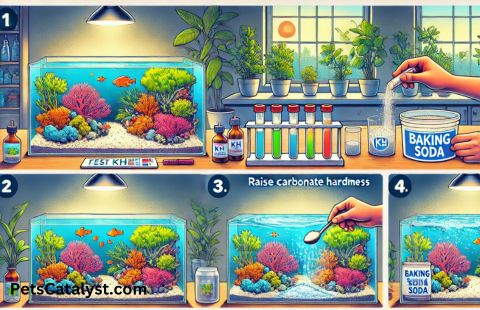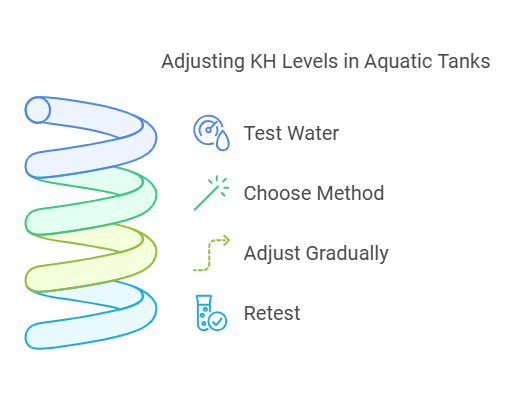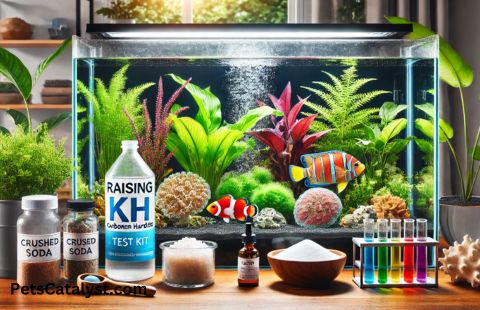Understanding how to raise KH in freshwater aquariums will give you a stable condition to keep your underwater friends alive. When you keep fish in freshwater aquariums, keeping KH is vital to maintain the stable water chemistry and healthy life. A lack of carbonate hardness causes your tanks pH to jump all over the place making for very unhappy fish, plants and even healthy bacteria.
To help you with this, I will provide some effective but easy to apply ways of raising and stabilizing KH in this article so that your aquarium becomes a beautiful water home.
What is KH and Why Should You Care?
KH may sound like a fancy chemistry term, but you can think of it as your aquariums invisible super hero. The one that stabilizes your underwater world and prevents pH fluctuations for the fishes swimming in it. With a history of raising numerous pets, I can attest that consistency is what creates a functional environment.
Understanding the Basics of KH
KH or carbonate hardness measures the carbonates and bicarbonate ions in your aquarium water. Think of it as your tanks immune system and it helps protect against a sudden change in pH that can be stressful or deadly to your little friends.
Video Credit: Majestic AquariumsTV
You May Like to Read:
Why Low KH is a Problem
Think of your aquarium as an ecosystem that exists in a balance delicately. Low KH means:
- Unstable pH levels
- Increased risk to fish health
- The potential for abrupt changes in the chemistry of water
Detecting Low KH: The Warning Signs
Always remember, test kit is your best friend. Let me inform you about some warning signs

- Sudden pH drops
- Fish showing stress symptoms
- Algae growth acceleration
- Unexplained fish health issues
Proven Methods to Raise KH in Your Freshwater Aquarium
Now it’s time to learn how to raise KH in a freshwater aquarium

Using Baking Soda
This is the quickest way to boost KH. Baking soda (sodium bicarbonate) is safe and effective when used correctly.
Dosage:
- Add 1 teaspoon per 10 gallons to raise KH by 1 dKH.
Steps:
- Dissolve baking soda in a cup of tank water.
- Add it gradually to avoid shocking your fish.
- Test KH levels after 24 hours.
Pro tip: Don’t overdo it! Sudden changes stress your fish.
Crushed Coral or Aragonite
These natural options work slowly but steadily.
How to use:
- Add crushed coral to your substrate or filter media.
- Use aragonite sand for a complete tank makeover.
They release carbonates gradually, stabilizing KH over time. Bonus? They can also help keep pH steady.
Limestone and Dolomite Rock
Adding limestone or dolomite rocks isn’t just decorative—it’s functional!
- Placement: Arrange these rocks as part of your tank’s aquascape.
- Impact: They slowly leach carbonates into the water, raising KH naturally.
Commercial KH Buffers
KH buffers are ready-made solutions for aquarium enthusiasts.
- Pros: Easy to use, precisely formulated for aquariums.
- Cons: Slightly pricier than DIY methods.
Follow the product instructions carefully to avoid overdosing.
Potassium Bicarbonate for Planted Tanks
If you have a planted tank, potassium bicarbonate is a fantastic option. It raises KH while supplying potassium—a nutrient plants adore.
Step-by-Step: Testing and Adjusting KH
- Test Your Water: Use a KH test kit to measure carbonate hardness.
- Choose a Method: Select one that suits your tank setup.
- Adjust Gradually: Sudden changes can shock your aquatic life.
- Retest: Check KH levels after adjustments to ensure you’re on target.

Maintaining Stable KH
Raising KH is one thing, but maintaining it is equally important. Here’s how:

- Routine Water Testing: Check KH weekly or biweekly.
- Choose the Right Water Source: Use tap water with a stable KH or remineralize soft water.
- Add Buffers Regularly: Use crushed coral, rocks, or commercial products for consistency.
| Task | Frequency | Details |
|---|---|---|
| Water Testing | Weekly or Biweekly | Test KH levels to ensure stability. Adjust based on readings. |
| Choose Right Water Source | As Needed | Use tap water with stable KH or remineralize soft water. |
| Add Buffers Regularly | Monthly or as Needed | Use crushed coral, limestone, or commercial products to maintain KH levels. |
| Monitor for Fluctuations | Ongoing | Watch for sudden drops in KH and adjust gradually. |
| Check pH Levels | Weekly | Ensure pH remains stable with balanced KH levels. Adjust if necessary. |
Consistency is key—both for your fish and your sanity!
FAQs
What happens if KH is too high?
Excessively high KH can make it tough to lower pH if needed. It’s rare but possible—use caution when adding buffers.
Can I raise KH without affecting pH?
Mostly, raising KH increases pH slightly. However, gradual methods like crushed coral minimize dramatic shifts.
How often should I test KH?
Weekly testing ensures your water stays stable. Test more often if you’re making adjustments.
What’s the best way to stabilize KH naturally?
Adding crushed coral or limestone is effective and requires little maintenance.
Can low KH hurt plants?
Yes! Plants need stable KH for photosynthesis and healthy growth.
As an aquarium hobbyist, increasing KH is not just a chemical process but a form of art. Due to the fact that you now know how to raise KH in freshwater aquarium conditions, are well on your way towards forming a stable underwater environment! Each modification, each meticulous measure is a step closer to an aquatic world in which your fish will be thanking you.
Remember, How to Raise KH in Freshwater Aquarium is a journey about patience, observation and love.
Note: Always seek advice for your particular species from a vet or aquarium specialist before attempting to raise KH.










